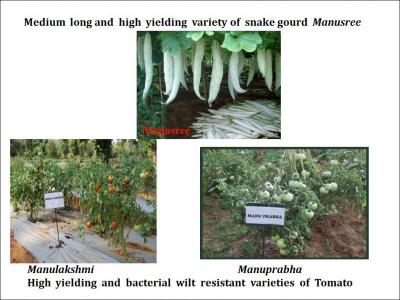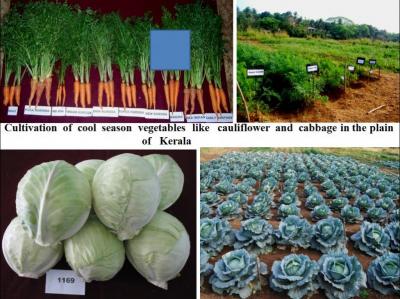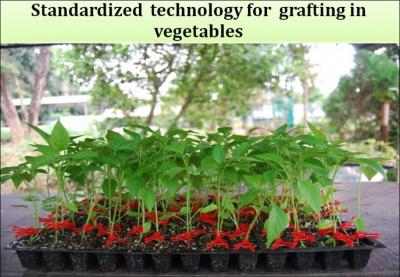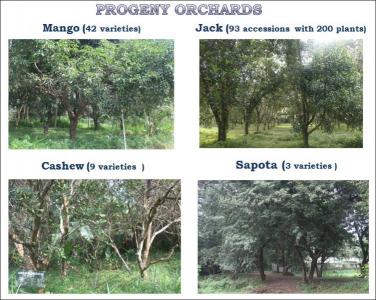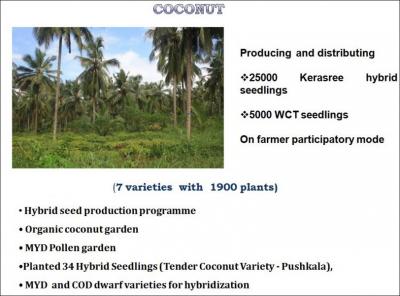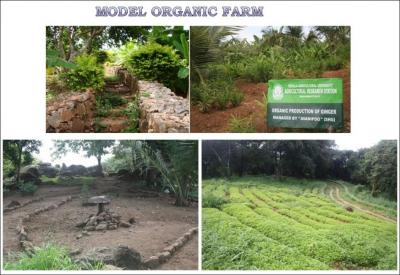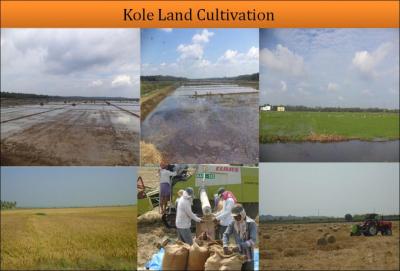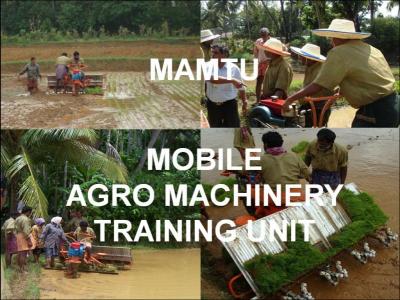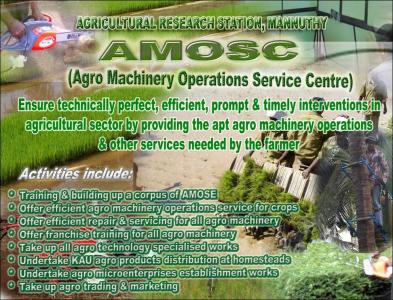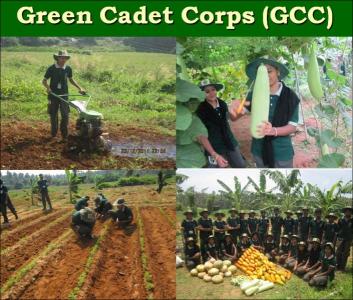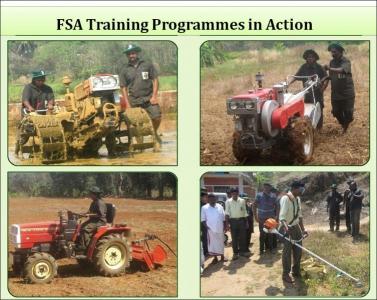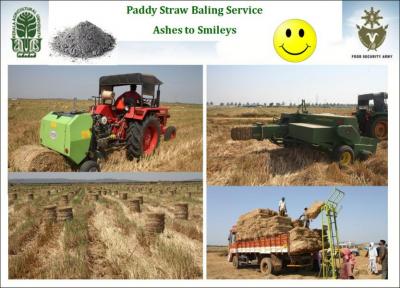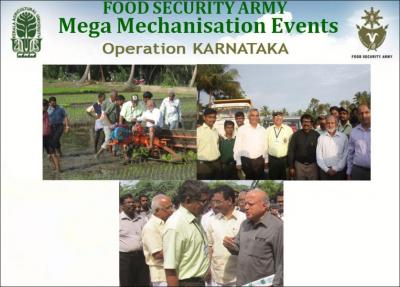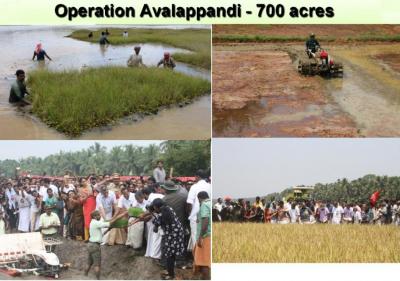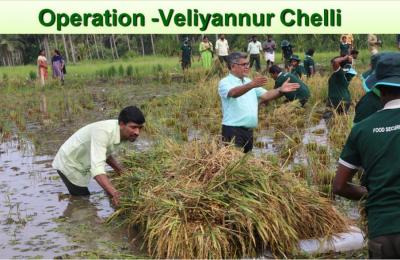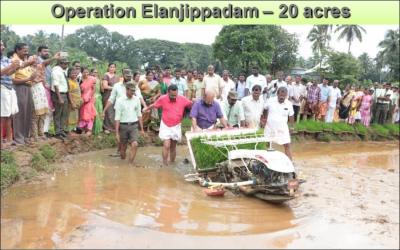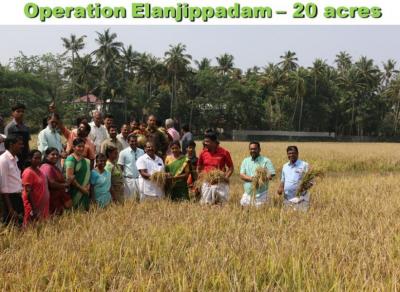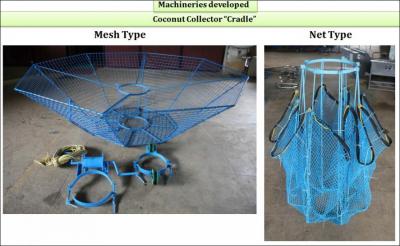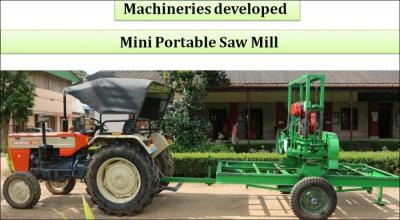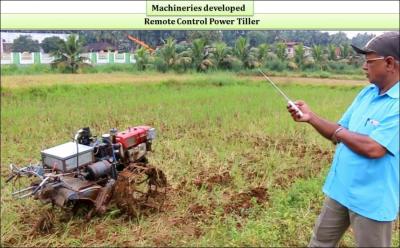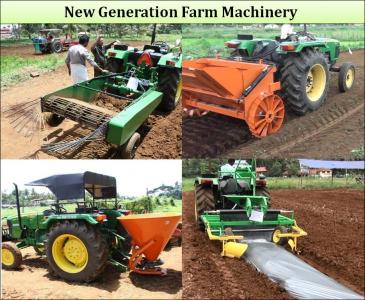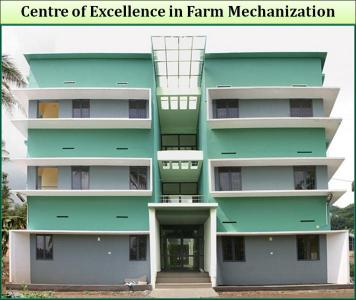RESEARCH HIGHLIGHTS
Crop Improvement
- Three groundnut varieties viz.TG-3, TG-14 and Spanish improved were found to be superior than the recommended varieties in yield and other economic trials.
- Evaluation of pulses and oil seed varieties for their performance in kole lands revealed that among the cowpea varieties, Krishnamony recorded the highest yield (1282 kg/ha). The green gram variety S-8 recorded the highest yield followed by PDM-54. Among the blackgram varieties, Pant-U-30 recorded the highest yield. Sesamum variety Sl-1885/l recorded the highest yield followed by TMV-2. The groundnut variety MK-374 recorded the highest yield followed by TG-14.
- A study on the effect of gamma irradiation on vegetatively propagated ornamental plants revealed that two mutants with variation in leaf size were observed in coleus. Canna and mussaenda were found to be highly sensitive to irradiation.
- An extra short duration rice variety was released as ‘Hraswa’ by the station which matures in 70 days. This is the first extra short duration variety of rice in the state.
- Descriptors were developed for 90 lines of cowpea and 50 lines of oriental pickling melon under NATP on plant diversity. Seeds were multiplied and deposited in the National Gene Bank under NATP Project on Plant bio diversity.
- Developed a short duration rice variety ‘Ahalya’ suitable for kole lands
- Developed non lodging, short duration rice variety ‘Manupriya’ for kole lands
- Three promising F1 Hybrids were developed in Bitter gourd.
- In the experiment to evaluate the performance of hybrid rice, the highest yield recorded for hybrid rice was only 7239 kg/ha
- HS-16, a selection from Hrawsa, with duration of 95-100 days and average grain yield of 5500ton/ha was developed and approved for release as a new variety for general cultivation and also as a very early variety, for the double cropped areas in kole lands.
- Short duration rice culture viz E39/2 and E56/2 and medium duration culture viz. Cul.6-08 and Cul.2-08 were found significantly superior to other cultures and check varieties.
- Among four hybrid varieties of aromatic rice with high yield evaluated Suruchi 5401 and Suruchi 5402 were performed better and were superior to check varieties.
- A new high yielding bacterial wilt resistant tomato variety “Manulakshmi” with oval shaped fruits was released in 2013.
- A new high yielding white fruited snake gourd variety “Manusree” with medium sized fruits was developed and released for cultivation in the state during 2004.
- A new high yielding bacterial wilt resistant round fruited tomato variety ‘Manuprabha’ with high fruit size was released for cultivation in the state during 2015.
- Exacum bicolor, a wild indigenous ornamental and medicinal plant has been successfully conserved ex situ. Fourteen genotypes is conserved as seed bank as well as field bank.
- Twenty genotypes of African Marigold evaluated for bacterial wilt resistance and one local collection was proved to be completely wilt free.
Crop Production
- Application of Benthiocarb @ 1.0 kg ai/ha at 6 days after sowing followed by a hand weeding at 30 days after sowing was the most effective and economical method of weed control in Kole lands.
- The study on nitrogen management for dry sown low land rice revealed that application of urea in the form of urea supergranules increased the grain yield in paddy. Application of fertilizers and enriched farm yard manure also recorded higher yield.
- Studies on increasing the efficiency of urea fertilizers in Kole lands revealed that application of 50 kgN/ha as rock phosphate coated urea was as effective as application of higher dose of N (up to 90 kg N/ha) as prilled urea or urea coated with any other materials tried.
- A project on pest and disease surveillance and management in kole lands revealed that pest and disease surveillance mechanism through Crop Security Intelligence Wing (CSIW). Officers is an effective means for the early detection of pest and diseases and also to control the problems before reaching economic threshold level. An awareness could be created among farmers regarding the misuse of poisonous pesticides, judicious application of fertilizers based on soil testing and to go for a safe crop production through CSIW officers. They play a key role for the grass root level understanding of the constraints in kole land cultivation and to come out with management measures.
- A study on bioefficiency test with new herbicides in transplanted rice of kole lands revealed that the lowest dry weight of weeds was recorded by Aniloguard + 2,4-D, (200 - 400g ai/ha). Since the sedges were the major weeds followed by Echinocholasp, 2,4-D played a vital role in controlling the weeds.
- Studies on Fertilizer management for kole land paddy recommended application of fertilizer dose of NPK @ 90:35:55 kg/ha for short duration varieties and 110:45:55 kg/ha for medium duration varieties in Kole lands.
- The weed management studies in the wet sown rice fields of kole lands revealed that most economic method of weed control in the wet sown rice fields of kole was found to be pre-emergent spraying of pretilachlor @ 0. 45 kg ai/ha at 3-4 DAS followed by one light hand weeding.
- A survey on soil analysis of kole lands revealed that there is a widespread deficiency of Calcium (50.9%), Magnesium (100%),Copper (65.4%), Zn (72%) and Boron (25.2%) in kole lands of Kerala.
- The studies conducted to find out the optimum dose of secondary and micro nutrients in kole lands revealed that application of MgSO4 @ 100 kg/ha, Borax @ 15 kg/ha, ZnSO4 @ 10kg/ha and CuSO4 @ 1 kg/ha in deficient areas of Mg, B, Zn and Cu respectively was found to be optimum for correcting the deficiency in kole lands and approved for inclusion in PoP.
- A survey conducted in Kole lands to develop a database of the weed flora of the ecosystem and to study the predominance and weed composition revealed that the grassy weeds were found to be the most serious problem in Kole lands and Fimbristylismiliaceae and Echinocloacolona were the most frequent and densely populated weeds in Kole wetlands of Kerala.
- The data on weed seed bank of the sediment in kole lands revealed that 1,75,000 wild rice seeds per hectare was found to be polluting the kole lands annually.
- The data on sedimentation load in two sites at kole lands indicated that 13.3 t/ha of soil in the form of silt or clay is deposited every year in kole lands. The analysis of the sediments for chemical properties revealed that the deposited soil was moderately acidic with normal electrical conductivity. It was rich in organic matter and contain high amount of available potassium (376.88 kg/ha). The sediment was found to be low with respect to available phosphorus content. The secondary nutrients viz. calcium and magnesium were found to be in the deficient range with 4.88 ppm of Ca and 21.67 ppm of Mg. The sulphur content was observed to be in the sufficient range. The results also indicated that the micronutrients viz. copper, iron, zinc and manganese were higher in the sediment.
- The nutrient studies in rice at kole lands revealed that application of boron and calcium silicate increased the uptake of primary and micronutrients and reduced the uptake of Fe and Mn. The total uptake of boron, calcium and magnesium had positive and significant correlation with yield whereas negative correlation existed between Fe uptake and yield.
- The media comprised of 80% RHC + 20% VC, 60% RHC + 20% soil + 20% VC and 80% RHC + 20% CC were found to be better in terms of quality and economics of mat nursery production of rice for mechanical transplanting and approved for inclusion in POP.
- Seed treatment with molybdenum @ 1g per kg of seed increased the grain yield in pulses.
- In double crop Kolelands, a medium duration rice (Jaya) followed by a short duration variety (Triveni) was found to be ideal.
- Among the different pulses tested in the Kole lands, cowpea performed better and the variety Krishnamany recorded the highest grain yield.
- The cropping system involving tapioca as intercrop in banana variety Nendran recorded the highest net return and 30.65% increase in profit was obtained.
- Studies on screening of groundnut varieties ideal for coconut gardens revealed that the highest yield was recorded by Spanish Improved (802.5 kg/ha) followed by TG 3 (557.5 kg/ha).
- Effect of 2,4-D applied as foliar spray on flowering and yield of brinjal was studied and results indicated that the highest fruit yield of 1718 kg/ha with 80% fruit set was obtained when 2ppm 2, 4-D was applied 30 days after planting.
- In a study to test suitability of various tuber crops as intercrop in irrigated Nendran banana, five types of tuber crops namely tapioca, amorphophallus, xanthosoma, sweet potato and dioscoria were grown as intercrop in Nendran banana and it was found that intercropping tapioca in irrigated Nendran banana is the most profitable.
- Spacing trial with the newly recommended varieties of groundnut namely TG-14, Spanish improved and TMV-2 planted at 6 spacings during summer and kharif seasons, revealed that during summer season closer spacing was found to be ideal for varieties TG-14 and Spanish improved, whereas a wider spacing was better for TMV-2.
- Evaluation of groundnut varieties for suitability as intercrop with tapioca revealed that maximum dry pod yield was obtained when groundnut variety TMV-2 was grown along with tapioca closely followed by Dh-8.
- The following pulse varieties were recommended for cultivation in Kole lands based on the three years experimental data in the cultivators field.
Cowpea – Krishnammany
Green gram- 88
Blackgram –Co2
Groundnut- TG3, TG14
- For bitter gourd, a fertilizer dose of NPK @ 50:50:25 kg/ha during the Rabi season and NPK @ 50:25:25 kg/ha during the summer season gave the highest yield.
- A fertilizer doze of 90:10:40 NPK kg/ha was found the best in terms of fruit yield for snake gourd
- Technology for cultivation of cool season vegetables like cauliflower and cabbage in the plains of Kerala was standardized.
- Lower level of irrigation (60% PE) was found to be sufficient for good performance of Cabbage and mulching significantly improved plant height plant spread, gross and net head weight. Fertilizer alone had no significant influence on yield attributing characters. The treatment combination of irrigation level at 60% PE, 125% of recommended fertilizer + mulch recorded significantly higher net head weight in the study.
- A modified package of practices for cultivation of cool season vegetables in the plains of Kerala was formulated and included in the Package of Practices Recommendations of the University.
- Developed adhoc package for poly house production of capsicum, palak, cucumber and tomato
- Standardized the technology for large scale production of virus free vegetable transplants under poly house in Kerala.
- Developed package of practice for open field precision farming in vegetables.
- Standardized technology for grafting solaneous vegetables like tomato, brinjal capsicum and chilies on resistant root stock to combat bacterial wilt.
- Higher level of irrigation (80% PE) is found to be optimum for good performance of Bhindi. Mulching significantly improved plant height, fruit yield, number of fruit and fruit weight than non mulched treatments. Fertilizer alone had no significant influence on yield attributing characters like fruit weight, number of fruit and fruit length. The combination of irrigation level at 80% PE, 125% of fertilizer + mulch recorded significantly higher plant height, fruit number and yield in the study.
Crop Protection
- Chemical evaluation trial with granules and sprays in rice revealed that the incidence of brown plant hopper was very less in Thimet and furadan treated plots in the trial with granules. In the trial with sprays, malathion and ekalux treated plots gave the best yields.
- Evaluation of neem cake urea carbofuran blends for increasing NUE and efficiency of carbofuran revealed that application of urea + neem cake + carbofuran as basal dressing followed by urea as top dressing recorded the highest grain and straw yield. On the other hand low grain yields were recorded when urea was used as per package of practices recommendations and in absolute control. Whorl maggot incidence was highest in absolute control.
Farm Mechanization
- A paddy winnower cum cleaner has been fabricated which has cleaning efficiency of 1000kg/hour for grain purposes and 600kg/hour for seed purpose.
- The machineries, Rice Transplanter was introduced and popularized in Kole lands.
- Conceptualization of “Food Security Army” Agro Machinery Operations Service Executives (AMOSE), Agro Machinery Operations Service Centre (AMOSC), Mobile Agro Machinery Training Unit (MAMTU), Mobile Agro Machinery Repair and Service Unit (MAMRSU) and Farm Machinery Facilitation Centre (FMFC).
- Missions for double cropping and augmenting productivity of kole lands, like “Operation Ponnamutha 300/5”, “Mission Elamutha 1000”, Padinjare Karimpadam P2= P1” and Save Manalur Thazham 710/7” were executed.
- New farm machinery Paddy Combine Harvester of different types were tested and popularized in Kole lands.
- Established farm machinery facilitation centre, for the farmers to meet all their agro machinery requirements. The centre (FMFC) offers machinery for hiring to farmers and caters their needs of repair and service through the agro machinery operation service centre (AMOSE). It also undertakes repair and service of agro machinery at farmers’ fields through the Mobile Agro Machinery Repair and Service Unit (MAMRSU). Both in house and on site Food Security Army trainings on different agro machinery such as tractor, mini tractor, power tillers, transplanters, paddy harvesters, threshers, winnowers, sprayers etc. were organized by the station, with the help of Food Security Army for the State and the Country, an army ready to meet all Agricultural contingencies.
- New farm equipment, KAU ‘Kera Suraksha Coconut Climber’ was designed and developed.
- ‘Paddy Straw Bailing’ service was introduced for first time in India with different paddy straw balers.
- Designed and developed a coconut basin digger for taking basins around coconut tree.
- Designed and developed modified model of Kera Suraksha Coconut Climber.
- Food Security Army training programme on farm mechanization is continuing and crossed 360 sessions (as of Dec, 2019 list).
- Mini portable saw mill was designed and developed for the onsite coconut wood sawing.
- Family Power Tiller was designed and developed for family farming with 10 attachments.
- A brush cutter was modified and developed to suit for operation by the physical handicapped persons with self starting system.
- A remote control power tiller was designed and developed.
- Designed and developed two types of Coconut Cradles – a) Mesh Type, b) Nylon Foldable Type Coconut Cradles.
ARS Mannuthy - Research Activities, Highlights & Achievements








